Historical Paints - Conservation Approaches
22nd Apr, 2019Historical Paints - Various Conservation Approaches
It is no surprise that the Scholarship has exposed us to a variety of interesting, dedicated conservation professionals and craftspeople. With that comes a wealth of conservation philosophies. 2017 Fellow Paul Walters spoke of a ‘conservation compass’ in his SPAB blog entry of 11 December 2017 (https://www.spab.org.uk/news/conservation-compass); I won’t repeat his words, but they certainly resonated with me having met such a variety of professionals on site, and discussing their varying approaches.
If we consider the SPAB ethos to be ‘north’ on our compass, then there is certainly some deviation from this point to be found. However, discussion between us Scholars and Fellows has shown that it is increasingly hard to decipher exactly where ‘true north’ lies. A number of the different philosophical approaches I have come across so far certainly exemplify what I would consider to be ‘pure' conservation practice, but with startlingly different results and physical manifestations on site. It goes to show that conservation practice is so wholly dependent upon each specific building, and the place and people connected with it. For example, the conservator must consider: When to repair using materials to match the existing, or use new materials? When to leave deteriorated fabric in-situ, or to reinstate? A case-by-case approach to conservation must be taken, within the framework of good SPAB practice and with our conservation compass pointing to our individual due north.
There are two examples which have particularly interested me, both related to historical paint conservation. Looking at historical paints and decorative schemes has been fascinating. As something I have always admired from afar without any technical understanding, it was brilliant to try our hand with paints, alongside the opportunity to learn how conservation can be done.
On 4th April 2019, we visited Hirst Conservation in Sleaford, Lincolnshire. Lucy Kaszewski gave us a fantastic introduction to traditional finishes for historic buildings, and a talk on the conservation of historic plaster, wall paintings and decorated architectural surfaces (with fun ‘hand-on’ practical experiences thrown in!)

Lucy gave us some key conservation principles and considerations to exemplify Hirst’s philosophy, including:
- Choosing the right paint (which includes consideration of finances, sustainability, safety, etc.)
- The approach of minimal intervention - always ‘less is more’.
- Doing a lot of recording and research (including surveys and initial tests) in advance, to find out if they really need to act.
- The best way forward comes from knowledge gathered, and analysis of any causes for damage/ deterioration, an understanding of significance/ value of the object, and a consideration of ongoing viability.
There are various causes of damage to historical finishes. Lucy Kaszewski discussed detrimental changes caused by damage and/or deterioration. The Grimsby Town Hall (1863) case study was an interesting example - in this case, there was general deterioration of the original paintwork, but Lucy specifically mentioned damage by neglect and perhaps un-witting vandalism. The original decorative scheme had been painted over, making the walls appear ‘ordinary’. Perception here was key - people were treating the walls badly, unaware of the special historic paint below. For example, maintenance were drilling holes for fixings and running cables without specific care and attention.
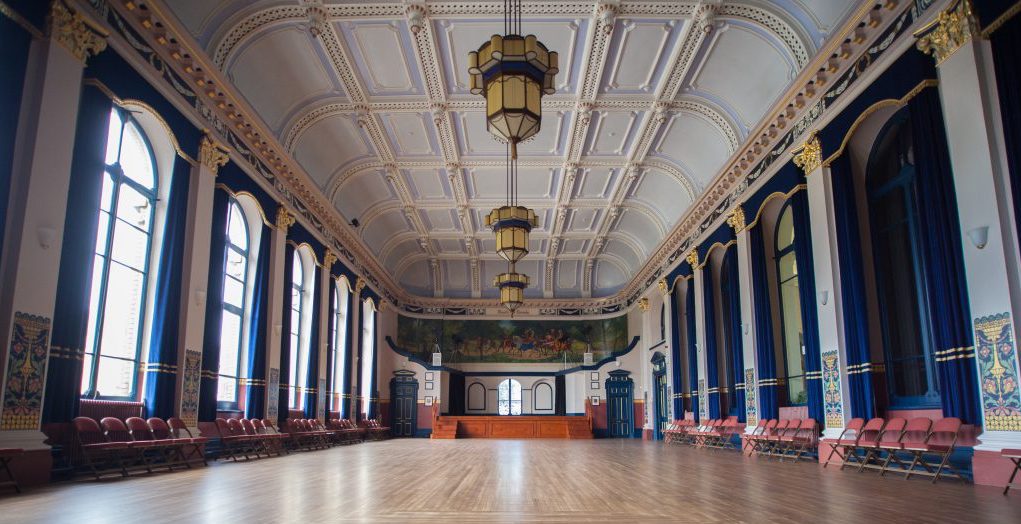
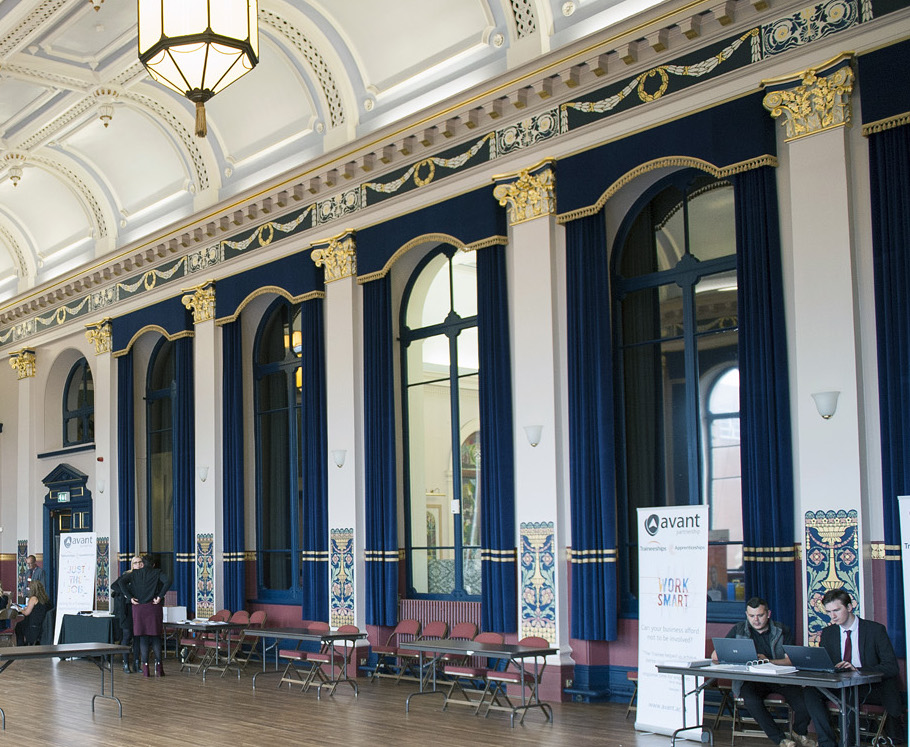
At Grimsby, Hirst’s research involved uncovering panels of the original paintwork to partially reveal the original decorative scheme. From these example panels, Hirst could digitally re-construct the entire original decorative scheme.
Financial restrictions (presumably amongst other factors) dictated that the original paint could not be wholly uncovered. Therefore, once studied, Hirst opted to recreate the original scheme in modern paints on top of the old. The existing historic paint is now mostly covered and protected.
Lucy described this approach as ‘facsimilie retouching’. The recreated scheme now engenders an attitude of care for the historic fabric. The conservation approach was originally due to financial restrictions, but had the benefit of changing the perception of the local people. The result is that maintenance teams have stopped drilling holes into the walls for sockets, and the public have a new respect for the walls too. By re-producing the old paint scheme, even in modern paints, Hirst thereby secured the building from future harm and preserved the original paintings underneath.
Critically, the new paint is discernible to a professional eye (for example by using vertical brush strokes and block colour, Hirst made it an obvious modern addition), but not to the public. The new paint increases legibility for a non-specialised viewer.
A more obvious approach was taken at St James the Great church in Dauntsey, during conservation work by Andrew Townsend Architects; we visited the church on 9 April 2019. A 14th century doom board was being reinstated above the rood screen of the church, but there were panels missing. Andrew Townsend adopted the ‘tratteggio’ approach - stippling in missing pieces of the doom painting, employing the colour scheme of the original. The effect is that the new panels are tonally in keeping with the old, but evidently a different paint scheme. The result is obvious to both professionals and the public.
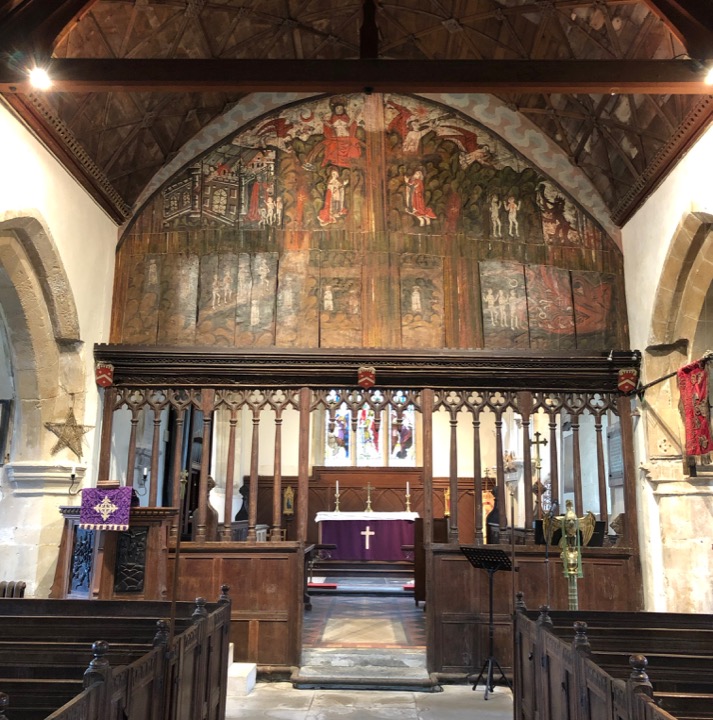
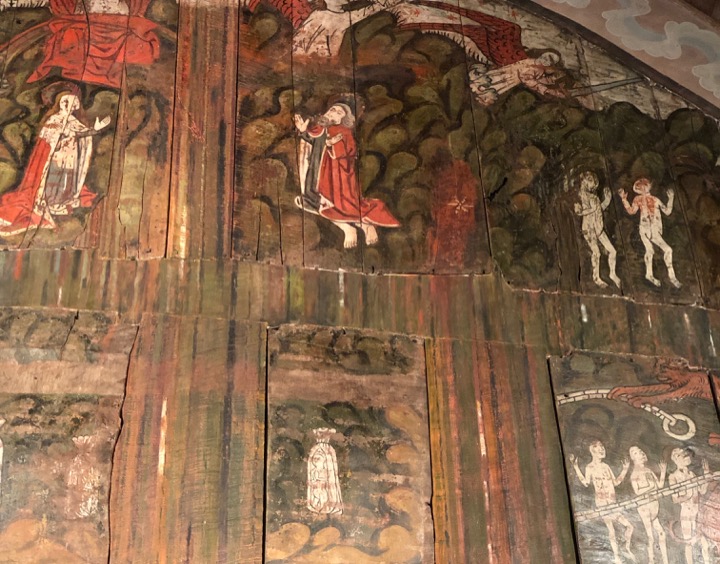 The doom board at St James the Great, Dauntsey, with 'tratteggio' finished fills to the missing panels.
The doom board at St James the Great, Dauntsey, with 'tratteggio' finished fills to the missing panels.
[As an aside, I now realise that we used a similar ‘tratteggio’ approach on the decorative painted Chancel ceiling of St Mary Magdalene church in Paddington, a project which I worked on at Caroe Architecture. At the time I was unaware of this term, and the approach was entirely new to me!]
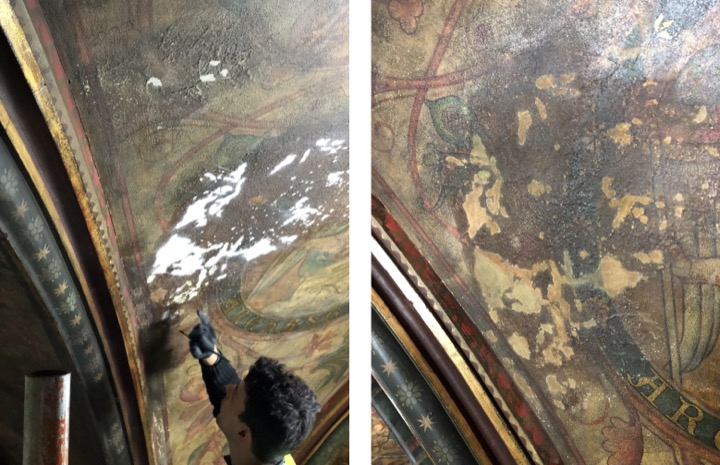 St Mary Magdalene Church, Paddington - similar 'tratteggio' style used in the salt damaged Chancel ceiling.
St Mary Magdalene Church, Paddington - similar 'tratteggio' style used in the salt damaged Chancel ceiling.
The different conservation approaches undertaken at Grimsby Town Hall and St James the Great are, in my opinion, both appropriate to their specific building, place and people. ‘True north’ lay in slightly different directions for these two projects, being dependent on their differing conditions and circumstances. These are just two examples of many more we have seen, and I am finding it increasingly interesting to learn the myriad philosophies being adopted and how these are manifested on site - I’m sure there will be more to come!